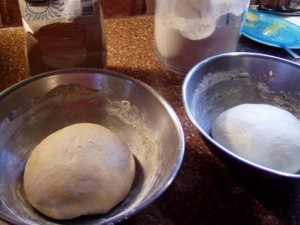 One of the more interesting things going on in the food world in the US is that region by region, state by state, farmers have made the decision to go back to growing fruits, veggies and grains that were grown in their areas a long time ago. Considering what can happen with climate change and bad weather in any particular growing season in any particular region, having more people growing more different stuff in more different areas is actually a good thing. Think of it as mutual funds for food.
One of the more interesting things going on in the food world in the US is that region by region, state by state, farmers have made the decision to go back to growing fruits, veggies and grains that were grown in their areas a long time ago. Considering what can happen with climate change and bad weather in any particular growing season in any particular region, having more people growing more different stuff in more different areas is actually a good thing. Think of it as mutual funds for food.
Now, the history of Upstate NY (where Aunt Toby lives) is very interesting in this regard – before the Midwest opened up in the later part of the 19th century, Upstate NY was basically one of the breadbaskets of the nation. Not only did farmers breed and select grains that grew best for them, but mills in places such as Rochester and Buffalo produced so much flour that they basically put New England mills out of business. Other regions of the country had their own specialty grains and flours as well – in the South, the wheat grown was softer, had less protein in it and was therefore better for making such items as cakes and biscuits. But with the centralization of grain growing in the Midwest part of the country (and therefore also the flour milling as well), grain growing in other regions almost disappeared. With climate change, crop failures and interest in historic grains growing, farmers in many regions have gotten back to growing their own regional grains and having them milled into flour.
Enter Cayuga Pure Organics, CPO which started as a small group of farmers in the Ithaca, NY area, interested in growing organic grains first for feed and then for human consumption. They partnered with other farmers and small businesses to form a milling company. I’ve been interested in trying out their bread flours because I frankly buy a giant bag of bread flour every year to make our own breads here at Chez Siberia. I’ve been more and more concerned about what’s in those big bags since they come from an area of the country where GM grain has basically taken over and I am very concerned about that. Cayuga Pure Organics grains are controlled – historic, regional, organic and non-GM. I thought I’d do a trial – my ‘big bag Midwest bread flour’ vs Cayuga Pure Organics bread flour, which is called ‘half white’. The protein in ‘half white’ is 12.7% which is smack dab in the range of protein for bread flours. Although my big bag doesn’t list protein content, I’m going to assume that it’s in the same range so that I can actually do a comparison.
Why do this? Well, one of the things I have read is that the grains that were traditionally grown in Upstate New York were what is called ‘soft winter wheat’, and one of the complaints about this type of grain is that supposedly the bread that is produced is not what we’re used to. Now, I’m not sure ‘what we’re used to’ is all that great, but I’m willing to see exactly what the results are going to be, in comparison to what we get when we use the ‘big bag of Midwest bread flour’.
I’m making both the same:
1 cup of hot water
1 T. yeast
¼ tsp of sugar
Enough flour to make a dough
Kneaded the same way and until the dough had the same consistency
Baked at the same time, in the same oven, at the same temperature.
Ready?
The top photo is what the two balls of dough looked like just after kneading and before being set to rise. The ‘half white’ is on the left; the ‘big bag bread flour’ is on the right. You’ll notice right away that the dough on the left is golden colored; the one on the right is white. I can tell you that the kneading was a very different experience. The ‘half white’ dough was a little bit sticky and dense; the ‘big bag bread flour’ dough was its usual mushy self.
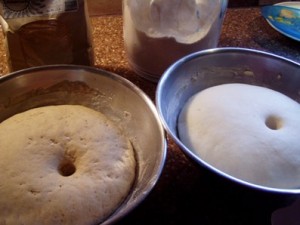 Here is what the two balls of dough looked like after 30 minutes of raising. Again – a lot more character to the ‘half white’ dough and I can tell you that the second kneading was exactly like the first, with the ‘half white’ dough showing a lot more character and resistance than the ‘big bag bread flour’ dough.
Here is what the two balls of dough looked like after 30 minutes of raising. Again – a lot more character to the ‘half white’ dough and I can tell you that the second kneading was exactly like the first, with the ‘half white’ dough showing a lot more character and resistance than the ‘big bag bread flour’ dough.
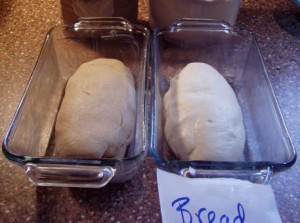 Here is what the two doughs looked like upon being put into glass baking dishes — basically the same size.
Here is what the two doughs looked like upon being put into glass baking dishes — basically the same size. 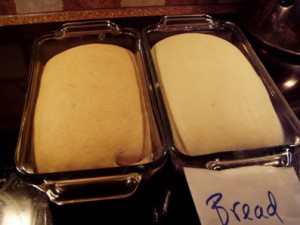 And here is what they looked like upon finishing their 30 minute raising. The ‘big bag bread flour’ one is marginally taller, but certainly not enough to get major points for that.
And here is what they looked like upon finishing their 30 minute raising. The ‘big bag bread flour’ one is marginally taller, but certainly not enough to get major points for that.
I put both dishes into a pre-heated 375 degree F. oven for 30 minutes.
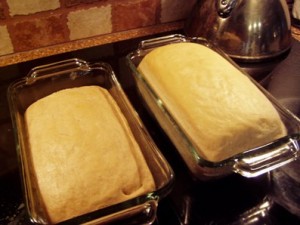 And here is the result. The ‘big bag bread flour’ dough kept rising in the heat. You’ll see from the photo that it raised above the top of the glass baking dish. The ‘half white’ dough not only did not raise any higher; it actually almost looks as if it shrank a little bit. What caused that?
And here is the result. The ‘big bag bread flour’ dough kept rising in the heat. You’ll see from the photo that it raised above the top of the glass baking dish. The ‘half white’ dough not only did not raise any higher; it actually almost looks as if it shrank a little bit. What caused that?
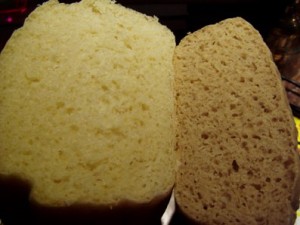 Let’s look at the crumb here – the ‘half white’ bread is a lot denser than the ‘big bag bread flour’ bread, which has a pretty loose crumb. Yes, I know that for many people, if the slice of bread doesn’t look like something that comes out of a plastic bag from the store, it’s not acceptable, but that is not an issue for us here. Both breads toast nicely and have good flavor and I can see that what I’d probably have to do to get a bigger loaf out of the ‘half white’ is more water and more flour to make a bigger ball of dough for the baking pan. The ‘big bag bread flour’ has a listing of ‘wheat flour and malted barley flour’, which sounds innocuous enough, but recent scientific findings show that the wheat which has been bread for commercial baking has all sorts of extra proteins and other things in it that the old traditional wheat strains do not.
Let’s look at the crumb here – the ‘half white’ bread is a lot denser than the ‘big bag bread flour’ bread, which has a pretty loose crumb. Yes, I know that for many people, if the slice of bread doesn’t look like something that comes out of a plastic bag from the store, it’s not acceptable, but that is not an issue for us here. Both breads toast nicely and have good flavor and I can see that what I’d probably have to do to get a bigger loaf out of the ‘half white’ is more water and more flour to make a bigger ball of dough for the baking pan. The ‘big bag bread flour’ has a listing of ‘wheat flour and malted barley flour’, which sounds innocuous enough, but recent scientific findings show that the wheat which has been bread for commercial baking has all sorts of extra proteins and other things in it that the old traditional wheat strains do not.
I think I’d rather go with using more water and flour and the local flour made from local non-GM wheat.

You can add malt to the organic local flour…as I recall, that’s what Laurel’s Bread Book recommended… malt something-or-other…only I could never find it. I think I’ve seen it at Whole Foods, though in recent years. No time to go look it up…I shoulda been in bed ages ago, but had to read this intriguing comparison.
Oh, forgot to add, when I was baking bread more, I sometimes added “wheat gluten”, from, I think Red Mill Farms or one of those organic producers you see in “health food stores.” Not Red Mill, Hodgson’s Mill maybe? That made it rise more, too.
I ditto Cheryl on wheat gluten, which both Bob’s Red Mill and Hodgson’s Mill market, both organic. It’s supposed to bump up the protein, good if you’re using whole wheat. About half a billion years ago, Jane Brody observed that whole wheat flours need extra time to rest and absorb the liquid. You also might try making a sponge – all the liquid with only a little of the flour, kind of like when proofing your yeast.
Awaiting further results!